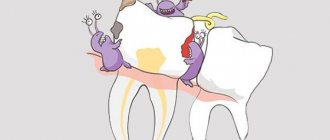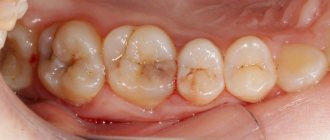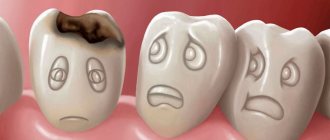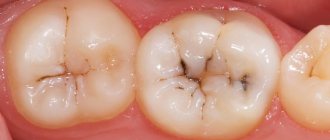Dental treatment. Why is it important to do this on time?
Visiting the dentist is one of those things that we most often put off until an indefinite “later.” The motive for this behavior is clear: few people can boast of a sincere love for visiting the dentist. Many people still remember the good old days, when they treated and removed teeth with weak anesthesia, or even without it, under the ominous rattling of an old drill in a dental office, where you still had to stand in a kilometer-long line. In addition, it can always turn out that everything is even worse than it seems, and a slight pain in the tooth is a symptom of some kind of pulpitis... In general, there is something to be imbued with a passionate desire to “not notice” the line in the diary that reads: “19-00 : Dentist".
When it comes to a routine examination, the reluctance to meet with a dentist is even greater: when nothing hurts, then there is no incentive to visit.
We often console ourselves with all sorts of considerations, among which the most popular are the following: “I have more important expenses to spend now,” “If caries already exists, it won’t go away: I’ll fly later,” “Maybe the pain will go away on its own, I’ll apply some salt.” . All this allows us to lull the voice of reason, which calls us to stop inventing nonsense and make an appointment, and, as practice shows, all such “lullabies” lead to the same result: we only make things worse for ourselves. The fact is that ALL problems with teeth and gums have the property of a linear course of the disease. This means that if you already have caries or inflamed gums, the disease will not disappear on its own
, will not go away, will not be cured on its own.
There are diseases that, even if we neglect them, can (but not necessarily) go away on their own: for example, a cold. But diseases of the teeth and gums are not one of these; on the contrary, caries will only deepen every day and “devour” your tooth deeper and deeper, risking turning into pulpitis or periodontitis, gum inflammation will become chronic, lead to the development of a serious disease and end with the loss of healthy teeth. There are no exceptions to this pattern! This means that if you do not solve the problem here and now, it will only get worse and may turn into a complication. When you finally get to the dentist, it may turn out that now you have not just a problem, but a Big Problem
, and you no longer just need to drill a little and put a neat filling, but, as they say, drill-cut-gouge, remove or make a prosthetic .
And financially, the amount will be completely different: for example, the cost of treating average caries is approximately 3 times lower than the cost of treating a common complication - pulpitis. As a result, you lose on all counts
: you significantly worsen the condition of your teeth, or even lose them, experience much greater inconvenience and pain, and spend amounts several times higher than what you would have paid initially.
In order not to be unfounded, let's consider the direct dependence of the type of treatment on the degree of neglect
of the most common dental disease -
caries
: •
Demineralization of enamel
(white spot stage, usually detected during a routine annual examination by the dentist).
Treatment: remineralizing therapy, consisting of repeated coating of the damaged area with fluoride-containing preparations. Forecasts: the most optimistic. With proper treatment and follow-up, it is possible to stop the progression of dental caries. • Enamel caries
.
Treatment: in some cases, the gentle method discussed above may help. Otherwise, a superficial preparation is carried out and a small filling is installed. The treatment is relatively quick and relatively painless, allowing for maximum tooth preservation. • Dentin caries
.
The most advanced version of caries without complications. Treatment: preparation and installation of fillings or microprosthetics in the form of ceramic inlays replacing fillings. Complications of caries
So, if you do not get to the dentist on time, caries inexorably moves into the next stage, which is expressed in all sorts of complications: •
Pulpitis
.
Treatment: is a set of measures. First of all, endodontic treatment (mechanical and medicinal treatment of root canals, as well as canal filling), then therapeutic (filling) or orthopedic (crown) tooth restoration. • Periodontitis
.
The treatment is similar to the treatment of pulpitis, but has its own characteristics. In some difficult cases, there is a need for surgical treatment (cystectomy with resection of the apex of the tooth, amputation of the tooth root, hemisection, etc.). Periodontitis is often complicated by periostitis
, an inflammation of the periosteum.
In this case, treatment is usually complex - endodontic (opening the root canals to drain pus), surgical (tooth extraction, an incision in the mucous membrane to drain pus in the area of the apex of the tooth root) and medication. However, it is not always possible to save a tooth. A small disclaimer: the specific type of treatment in each individual case is chosen by the dentist
and takes into account all the features of the development of the disease.
The stages of development of caries and complications that we have listed and the corresponding treatment methods are given so that you understand the direct dependence of the complication of the problem on its neglect. The more advanced the caries, the more serious methods are used - even those that can only be dreamed of in a nightmare by a person with dental problems. And this applies not only to caries, but also to other dental diseases. For example, many perceive the presence of tartar
as a purely aesthetic problem.
But in fact, tartar is the main cause of gum disease, and also contributes to the development of caries and related diseases. If you remove it regularly, there will be no problem at all. If you neglect it, you will get sore gums and other complications. Calendar of dental treatment and prevention
You should undergo a routine examination by a dentist once every six months: this is exactly the period during which not a single disease of the teeth and gums will go into an advanced state. But if you feel pain or see suspicious spots on your tooth, the onset of caries, if your gums are bleeding or inflamed, contact your dentist immediately!
Beautiful smile. How to achieve this?
diseases of the teeth and oral cavity dentist dentistry health control prevention tooth gums
Why do teeth deteriorate?
If we do not wait for the teeth to miraculously heal themselves and begin treatment immediately, we will prevent tooth loss and get rid of toothache. Where does caries come from, which destroys our teeth? When sugar enters the oral cavity, bacteria begin to act on it, turning the sugar into acids. These acids loosen tooth enamel, resulting in a cavity and tooth decay. At this stage there is no discomfort, but when the disease reaches the pulp stage, severe pain will occur!
The most common dental disease
Among dental diseases, the most common is caries, that is, the gradual destruction of tooth tissue. It is believed that around the world, for every one healthy person, there are nine people suffering from dental caries. If you violate the rules of oral hygiene, plaque will accumulate on your teeth, active proliferation of pathogenic microorganisms will begin, the balance of minerals in tooth enamel will be disrupted, it will begin to deteriorate, after which dental treatment . Timely identification of the problem and contacting a specialist will make the treatment process quick and problem-free.
Detailed information about dental treatment , dental equipment, prevention of dental diseases, and many other issues related to dental health can be found on the StomInfo website.
0
Treatment of dental cyst
A cyst is a formation or lump that contains dead cells inside pus. The cyst is located at the apex of the root canal. The main danger of this pathology is its asymptomatic course.
A cyst is diagnosed mainly when visiting a doctor for problems with other teeth. The formations are clearly visible on x-rays. The cyst is constantly growing in size, so in advanced stages swelling and pain appear. Treatment of teeth with cysts can be surgical or therapeutic. When treating a cyst, it is worth assessing the condition and distribution of the formation.
Therapeutic dental treatment lasts longer and does not guarantee a complete cure, but the patient is less susceptible to stress. With this approach, antibiotics are used to disinfect and “suck” drugs into the root canal.
Surgical dental treatment involves complete removal of the cyst, which guarantees a cure, but not all patients agree to such an intervention.
It's easier to prevent than to cure
Every day a person consumes food, the digestion of which, under the influence of salivary enzymes, begins in the oral cavity. Residues of consumed food accumulate on the teeth. If they are not removed in time, the teeth become covered with plaque and an unpleasant odor appears from the mouth. Long-term neglect of cleaning procedures leads to the occurrence of diseases and the need for dental treatment .
Interesting! Chinese dictator Mao Zedong never brushed his teeth, explaining this by adherence to ancient traditions.
He rinsed his mouth with green tea and chewed the leaves of tea bushes. By the end of his life, his teeth were covered with a greenish coating. From a very early age, children should be taught the basic rules of daily oral hygiene. This includes procedures such as:
- every morning and nightly brushing your teeth with a brush and toothpaste or powder;
- the use of dental floss and toothpicks to sanitize the space between teeth;
- rinsing the mouth after meals using special disinfectant solutions.
It is also necessary to eat properly, maintain a balance of microelements in the body, and, if necessary, take vitamin complexes.
Treatment of dental caries
The most common reason for visiting the dentist is caries, a disease characterized by softening of the enamel. Oral bacteria have a penetrating and subsequently destructive effect on the enamel. The following factors contribute to the development of this disease:
- poor oral hygiene or regular non-compliance with it;
- unhealthy diet: eating large amounts of fatty and sweet foods, without including raw vegetables and fruits in the diet;
- poor water (low saturation of drinking water with minerals - calcium, fluorine, phosphorus);
- low immunity;
- intestinal diseases.
Proper treatment of dental caries involves going through several stages of filling:
- First of all, it is necessary to clean the enamel surface from plaque. This removes hard and soft deposits. Treatment of dental caries can occur either with the help of a burr with a special attachment, or with the use of ultrasonic devices, mixtures and brushes.
- Determination and selection of filling color. This is an important stage due to the fact that when filling teeth in the smile area, the filling should not be noticeable.
- Pain relief if necessary. If the hole is already deep and is in close proximity to the nerve, local anesthesia is recommended.
- Treatment of dental caries using a drill or laser. The edges of the enamel around the affected area are also removed. The hole needs to be widened to remove the darkened areas. This is necessary to ensure that inflammation does not spread under the filling.
- Etching – surface treatment with a special acid.
- Filling is the restoration of the original shape of the damaged tooth through the gradual application of filling material.
- Polishing and getting rid of unevenness.
Why do you need timely dental treatment?
Toothache is not the worst thing that happens when you have dental disease.
The main problem is that an infection enters the maxillofacial system, which multiplies and spreads deep into the tissues. Diseases very quickly turn into more severe ones. Teeth decay and, if you do not see a doctor in time, may fall out. In this article on Stom-Firms.ru we look at how teeth are treated and what to do to avoid letting them become painful.









